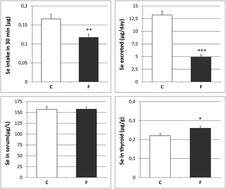Metabolic syndrome and selenium in fetal programming: gender differences
Abstract
Objectives: Since Selenium (Se) forms part of glutathione peroxidase (GPx), which appears to have a dual role in Metabolic Syndrome (MS), this study evaluates the implication of Se in the transmission of this pathology to the progeny. Methods: Se body distribution, glucose, triglycerides, cholesterol, insulin and metabolic hormones [glucagon, leptin, gastric inhibitory polypeptide (GIP), and triiodothyronine (T3)], growth factors, receptor activator of nuclear factor kappa-B ligand (RANK-L) and osteopontin, as well as oxidative hepatic balance in the offspring of dams exposed to a fructose-rich diet (65%) with normal Se content (0.01 ppm) during gestation and lactation, were measured according to sex. Results: Fructose pups had lower body weight; however, male pups had a lower body mass index and growth indicators in serum. Fructose pups, especially females, had lower levels of serum insulin and HOMA-IR. With regard to Se homeostasis, fructose pups presented a depletion of Se in heart and muscle, and repletion in kidneys, pancreas and thyroid, although only female pups showed a repletion of Se in the liver. Fructose pups presented lower superoxide dismutase activity and only female fructose pups had higher GPx activity, which provoked hepatic oxidation. Conclusions: Se balance and Se tissue deposits in MS pups during lactation are altered by gender. This difference is focused on hepatic Se deposits that affect GPx activity, which could be related to a disruption in the insulin-signaling cascade in females. Furthermore, although female fructose pups had greater metabolic disorders, only the males’ growth and development were affected. Particularly relevant is the depletion of Se found in the heart of fructose pups, as this element is essential for correct heart function.



 Please wait while we load your content...
Please wait while we load your content...